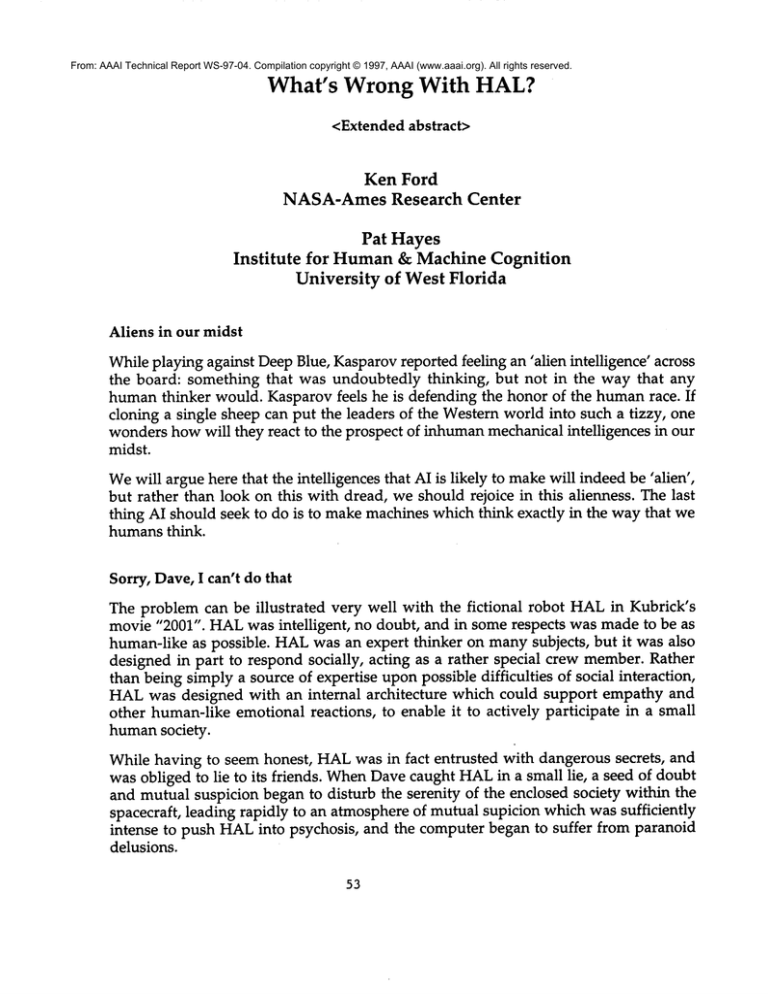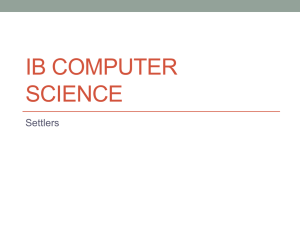
From: AAAI Technical Report WS-97-04. Compilation copyright © 1997, AAAI (www.aaai.org). All rights reserved.
What’s Wrong With HAL?
<Extended abstract>
Ken Ford
NASA-AmesResearch Center
Pat Hayes
Institute for Human& Machine Cognition
University of West Florida
Aliens in our midst
While playing against Deep Blue, Kasparov reported feeling an ’alien intelligence’ across
the board: something that was undoubtedly thinking, but not in the way that any
human thinker would. Kasparov feels he is defending the honor of the human race. If
cloning a single sheep can put the leaders of the Western world into such a tizzy, one
wonders how will they react to the prospect of inhuman mechanical intelligences in our
midst.
Wewill argue here that the intelligences that AI is likely to makewill indeed be ’alien’,
but rather than look on this with dread, we should rejoice in this alienness. The last
thing AI should seek to do is to make machines which think exactly in the way that we
humans think.
Sorry, Dave, I can’t do that
The problem can be illustrated
very well with the fictional robot HALin Kubrick’s
movie "2001". HALwas intelligent,
no doubt, and in some respects was made to be as
human-like as possible. HALwas an expert thinker on many subjects, but it was also
designed in part to respond socially, acting as a rather special crew member. Rather
than being simply a source of expertise upon possible difficulties of social interaction,
HALwas designed with an internal architecture
which could support empathy and
other human-like emotional reactions, to enable it to actively participate in a small
human society.
While having to seem honest, HALwas in fact entrusted with dangerous secrets, and
was obliged to lie to its friends. WhenDave caught HALin a small lie, a seed of doubt
and mutual suspicion began to disturb the serenity of the enclosed society within the
spacecraft, leading rapidly to an atmosphere of mutual supicion which was sufficiently
intense to push HALinto psychosis, and the computer began to suffer from paranoid
delusions.
53
The point of this is to emphasise how much HAL’s deviant behavior resulted from a
breakdown in its social relationships with the crew. This could only happen because
HALwas constructed to imitate human thinking in a remarkably thorough way. HAL
was built to be too human.
Chess: Manvs. Machine?
One criticism of chess-playing programs often made within AI is that since chess is an
artificial, restricted, ’brittle’ domain,success at chessplaying tells us little about general
techniques for learning how to improve problem-solving skills (say). A rather different
criticism made from outside AI is that regardless of who wins, humanchess-players are
still uniquely humanbecause the machines think differently.
These are really two sides of the same objection, motivated by the legacy of Turing’s old
Test. Turing’s motivation was to replace a vague goal of building an ’intelligent’ machine
by a more concrete one which could be tested objectively.
Thinking of the task of
building a chess-playing program in the same way renders both of these objections
pointless. Nobodycriticises a cheesegrater for being ill-adapted to making omelettes, or
the fact that its methods don’t yield insights into the general nature of friction, so why
are similar objections thought to be relevant when applied to chess-playing programs or
any other AI program designed to perform a particular intellectual
task? The reason
seems to be that a chess-playing program is thought of as merely a step towards a larger
goal of making something which thinks like a human. From this perspective these
criticisms make sense; but if ones goal is to make a chessplayer, having it think like a
human is a positive disadvantage. While humans have many intellectual
talents, they
also have many weaknesses: limited short-term memorycapacity, easily distracted by
irrelevant stimuli, emotional reactions which divert energy and so on. The aim of building
a chess-playing tool is to surpass humanchess performance, not to imitate it.
Calling Deep Blue a ’tool’ reflects an attitude towards AI which we think is a more
promising one than the traditional Turing vision. The goal of AI, on this view, is to
make machines which amplify and extend our intelligence,
just as the steam shovel
amplified and extended the way that our muscles can dig dirt. Another way to think of
this chess match is as not being between Kasparov and Deep Blue, but between the
current chess champion and a human being who is using Deep Blue to help him choose
his moves. The remarkable thing is that the manwith the chess-tool is able to do so well
when he knows so little chess. Evidently this chess-tool is enormously useful, if chess
playing is your business.
Deep Blue is muchmore like a tool than an independent agent. It doesn’t have its own
agenda. It has no purpose other that for which it was designed, and is highly optimised
to this very specialised use. All it does is figure out a good movefrom a chess position.
If we regard a scientific calculator as a tool, Deep Blue surely is in the same category.
However,this is not to say that Deep Blue is not intelligent. If chess-playing requires
54
intellectual ability, then of course a successful chess-playing program is intelligent.
Suppose someone had a dog that was the second-best chess player in the world; everyone
would surely agree that this was a very smart dog, even if it couldn’t hold a human
conversation or fully understand the concept of ’chess match’. The lesson of AI is that
we can make intellectual
tools -- cognitive prostheses m which have no independent
social role, no human pretensions or weaknesses, but yet have genuine intellectual
power. They really do think, in manyways better than we can. Which is, of course, our
reason to build them. Like any other tool, they help us do things we could not manage
to do without them.
Notice that the alien quality of a tool is critical. Wereit not alien in some way, there
would be no use for it. That is what tools are for: to perform some function which is
beyond our capacity to perform without it. Whether that task be loading coal or playing
chess, the relationship between humanand machine is similar. Mechanizing these talents
beyond that of a naked human being does not reduce or demean human dignity or
threaten us, but rather expands our humancapability. Before industrial mechanization,
a strong muscular body was a valuable economic resource. Strong bodies are still admired,
but nowonly for essentially aesthetic reasons. Until recently it took years of dedication
to learn to play chess really well, but nowfor less than a hundred dollars anyone can
buy a chess tool and use it to play chess close to the master level.
Howeverit is worth noting that, like manyAI programs, Deep Blue is not totally alien.
Human chess players also perform lookahead and evaluate future positions.
The
differences between Deep Blue and Kasparov are more quantitative than qualitative.
Our second critic is right to claim that humanthinkers have talents which we cannot
mechanize (yet), but the moral of these chess matches is that these other skills which
Kasparov uses -- the ability to recognize ’meaningful’ chess patterns, for example m
are rendered unnecessary simply by magnifying a limited sub-collection
of human
talents by the speed and reliability of the computer. A sufficiently fast ’dumblookahead’
can overcome the craftiest humancombinations of multiple mental skills. Once again,
we urge an optimistic conclusion. Consider the possibility
for making more useful
synergies between man and computer when the computer is used to amplify and accelerate
parts of human thought many orders of magnitude past the capacity of an unaided
human brain.
On measurement
Finally, another reason why chess-playing programs are something of a model for AI is
that chess performance can be measured quite objectively and qualitatively,
in notable
contrast to most of the performance goals which AI has tackled. Wewould argue that
AI research generally should seek more such objective performance scales.
55



